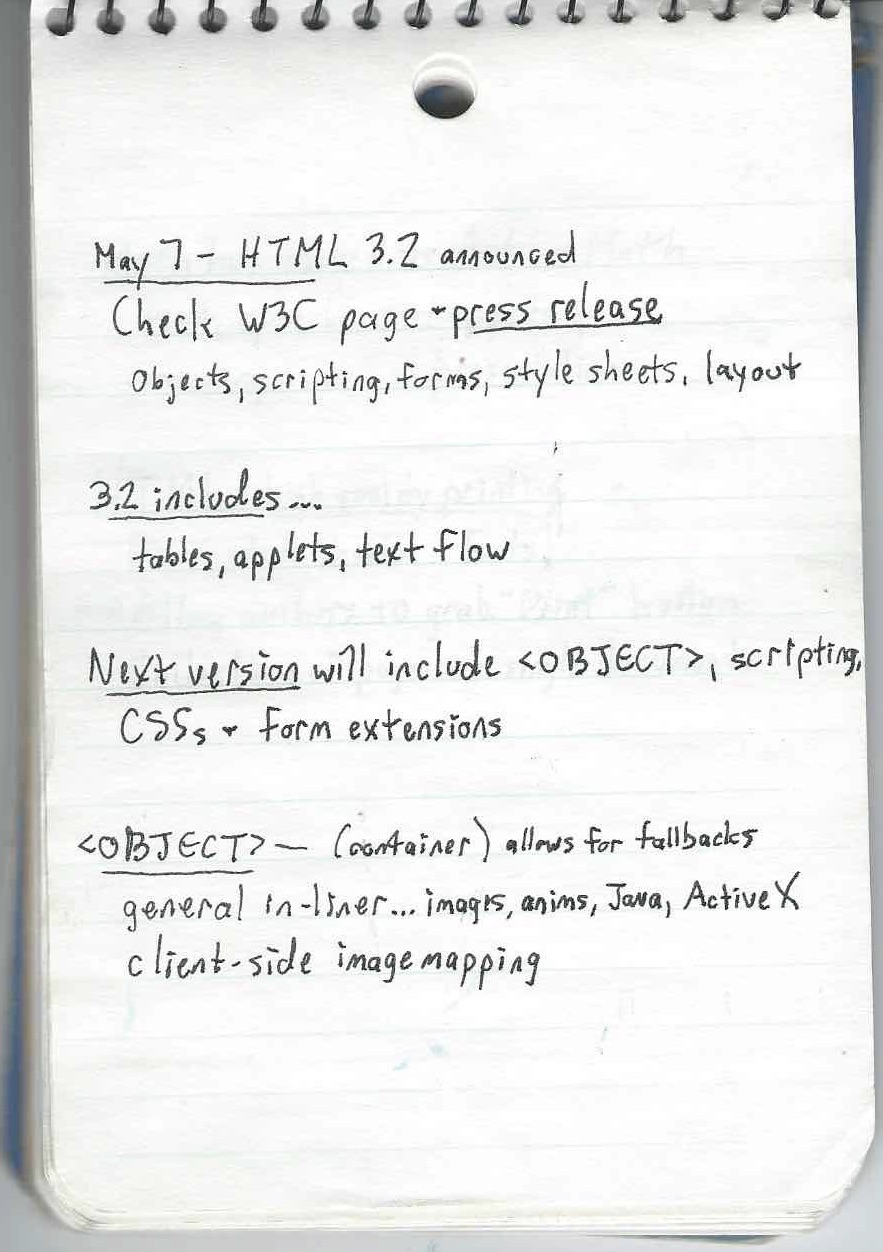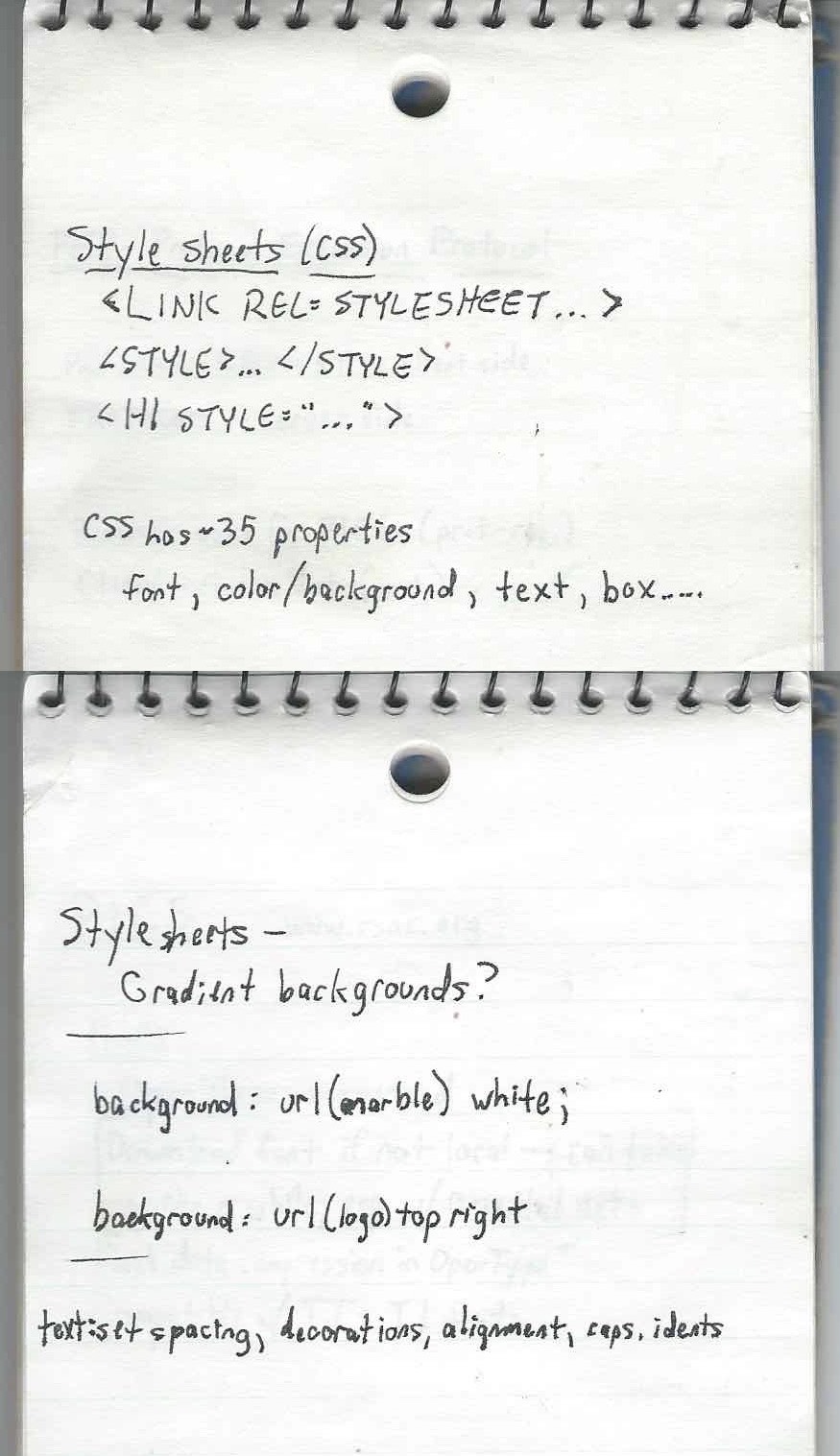Dave
asked people to share their CSS wish lists for 2023, and even though
it’s well into the second month of the year, I’m going to sprint
wild-eyed out of the brush along the road, grab the hitch on the back of
the departing bandwagon, and try to claw my way aboard.
At first I thought I had maybe four or five things to put on my list,
but as I worked on it, I kept thinking of one more thing and one more
thing until eventually I had a list of (checks notes) sixt — no, SEVENTEEN?!?!? What the hell.
There’s going to be some overlap with the things being worked on for
Interop 2023, and I’m sure
there will be overlap with other peoples’ lists. Regardless, here we
go.
Subgrid
Back in the day, I asserted Grid should wait for subgrid. I was
probably wrong about that, but I wasn’t wrong about the usefulness of
and need for subgrid. Nearly every time I implement a design, I trip
over the lack of widespread support.
I have a blog post in my head about how I hacked around this problem
for wpewebkit.org by applying the
same grid column template to nested containers, and how I could make it
marginally more efficient with variables. I keep not writing it, because
it would show the approach and improvement and then mostly be about the
limitations, flaws, and annoyances this approach embodies. The whole
idea just depresses me, and I would probably become impolitic.
So instead I’ll just say that I hope those browser engines that have
yet to catch up with subgrid support will do so in 2023.
Masonry layout
Grid layout is great, and you can use it to create a masonry-style
layout, but having a real masonry layout mechanism would be better,
particularly if you can set it on a per-axis basis. What I mean is, you
could define a bunch of fixed (or flexible) columns and then say the
rows use masonry layout. It’s not something I’m likely to
use myself, but I always think the more layout possibilities there are,
the better.
Grid track styles
For someone who doesn’t do a ton of layout, I find myself wanting to
style grid lines a surprising amount. I just want to do something
like:
display: grid;
gap: 1em;
grid-rules-columns: 1px dotted red;
…although it would be much better to be able to style separators for
a specific grid track, or even an individual grid cell, as well as be
able to apply it to an entire grid all at once.
No, I don’t know exactly how this should work. I’m an idea guy! But
that’s what I want. I want to be able to define what separator lines
look like between grid tracks, centered on the grid lines.
Anchored positioning
I’ve wanted this in one form or another almost since CSS2 was
published. The general idea is, you can position an element in relation
to the edges of another element that isn’t a containing block. I wrote
about this a bit in my post on connector lines for wpewebkit.org, but
another place it would have come in handy was with the
footnotes on The Effects of Nuclear Weapons.
See, I wanted those to actually be sidenotes, Tufteee-styleee. Right now, in order to make sidenotes, you have to stick the footnote into the text, right where its footnote reference appears — or, at a minimum, right after the element containing the footnote reference. Neither was acceptable to me, because it would dork up the source text.
What I wanted to be able to do was collect all the footnotes as
endnotes at the end of the markup (which we did) and then absolutely
position each to sit next to the element that referenced them, or
have it pop up there on click, tap, hover, whatever. Anchored positioning
would make that not just possible, but fairly easy to do.
Exclusions
Following on anchored positioning, I’d love to have
CSS Exclusions
finally come to browsers. Exclusions are a way to mark an element to
have other content avoid it. You know how floats move out of the normal
flow, but normal-flow text avoids overlapping them? That’s an exclusion.
Now imagine being able to position an element by other means, whether
grid layout or absolute positioning or whatever, and then say “have the
content of other elements flow around it”. Exclusions! See this
article by Rob Weychert for a more in-depth explanation of a common
use case.
Element transitions
The web is cool and all, but you know how futuristic interfaces in
movies have pieces of the interface sliding and zooming and popping out and all that
stuff? Element transitions. You can already try them
out in Chrome Canary, Batman, and I’d love to see them across the
board. Even more, I’d love some gentle, easy-to-follow tutorials on how
to make them work, because even in their single-page form, I found the
coding requirements basically impossible to work out. Make them all-CSS,
and explain them like I’m a newb, and I’m in.
Nested Selectors
A lot of people I know are still hanging on to preprocessors solely
because they permit nested selectors, like:
main {
padding: 1em;
background: #F1F1F0;
h2 {
border-block-end: 1px solid gray;
}
p {
text-indent: 2em;
}
}
The CSS Working Group has been wrestling with this for quite some
time now, because it turns out the CSS parsing rules make it hard to
just add this, there are a lot of questions about how this should
interact with pseudo-classes like :is(), there are serious
concerns about doing this in a way that will be maximally
future-compatible, and also there has been a whole lot of argument over
whether it’s okay to clash with Sass syntax or not.
So it’s a difficult thing to make happen in native CSS, and the
debates are both wide-ranging and slow, but it’s on my (and probably
nearly everyone else’s) wish list. You can try it out in Safari Technology Preview
as I write this, so here’s hoping for accelerating adoption!
More and better :has()
Okay, since I’m talking about selectors already, I’ll throw in
universal, full-featured, more optimized support for
:has(). One browser doesn’t support compound selectors, for
example. I’ve also thought that maybe some combinators would be nice,
like making a:has(> b) can be made equal to
a < b.
But I also wish for people to basically go crazy with
:has(). There’s SO MUCH THERE. There are so many
things we can do with it, and I don’t think we’ve touched even a tiny
fraction of the possibility space.
More attr()
I’ve wanted attr() to be more widely accepted in CSS
values since, well, I can’t remember. A long time. I want to be
able to do something like:
p[data-size] {width: attr(data-width, rem);}
<p data-size="27">…</p>
Okay, not a great example, but it conveys the idea. I also talked
about this in my
post about aligning table columns.
I realize adding this would probably lead to
someone creating a framework called Headgust where all the styling is
jammed into a million data-*attributes and the whole of the
framework’s CSS is nothing but property: attr() declarations
for every single CSS property known to man, but we shouldn’t let that stop us.
Basically I want to be able to do this:
:root {--mobile: 35em;}
@media (min-width: var(--mobile)) {
/* non-mobile styles go here */
}
That’s it. This was made possible in container queries, I believe, so
maybe it can spread to media (and feature?) queries. I sure hope so!
Logical modifiers
You can do this:
p {margin-block: 1em; margin-inline: 1rem;}
But you can’t do this:
p {margin: logical 1em 1rem;}
I want to be able to do that. We should all want to be able
to do that, however it’s made possible.
Additive values
You know how you can set a bunch of values with a comma-separated
list, but if you want to override just one of them, you have to do the
whole thing over? I want to be able to add another thing to the list
without having to do the whole thing over. So rather than adding a value
like this:
background-clip: content, content, border, padding; /* needed to add padding */
…I want to be able to do something like:
background-clip: add(padding);
No, I don’t know how to figure out where in the list it should be
added. I don’t know a lot of things. I just know I want to be able to do
this. And also to remove values from a list in a similar way, since I’m
pony-wishing.
Color shading and blending
Preprocessors already allow you to say you want the color of an
element to be 30% lighter than it would otherwise be. Or darker. Or
blend two colors together. Native CSS should have the same power. It’s being
worked on. Let’s get it done, browsers.
Hanging punctuation
Safari has supported hanging-punctuation forever (where “forever”,
in this case, means since 2016) and it’s long past time for other browsers
to get with the program. This should be universally supported.
Cross-boundary styles
I want to be able to apply styles from my external (or even embedded) CSS to a resource like an external SVG. I realize this sets up all kinds
of security and privacy concerns. I still want to be able to do it. Every time I have to embed an entire inline SVG into a template just so
I can change the fill color of a logo based on its page context, I grit
my teeth just that little bit harder. It tasks me.
Scoped styling (including
imports)
The Mirror Universe version of the previous wish is that I want to be
able to say a bit of CSS, or an entire style sheet (embedded or
external), only applies to a certain DOM node and all its descendants.
“But you can do that with descendant selectors!” Not always. For that
matter, I’d love to be able to just say:
<div style="@import(styles.css);">
…and have that apply to that <div> and its
descendants, as if it were an <iframe>, while
not being an <iframe> so styles from the
document could also apply to it. Crazy? Don’t care. Still want it.
Linked flow regions(?)
SPECIAL BONUS TENTATIVE WISH: I didn’t particularly like how CSS Regions were
structured, but I really liked the general idea. It would be really
great to be able to link elements together, and allow the content to
flow between them in a “smooth” manner. Even to allow the content from
the second region to flow back into the first, if there’s room for it
and nothing prevents it. I admit, this is really a “try to recreate
Aldus PageMaker
in CSS” thing for me, but the idea still appeals to me,
and I’d love to see it come to CSS some day.
So there you go. I’d love to hear what you’d like to see added to CSS, either in the comments below or in posts of your own.





